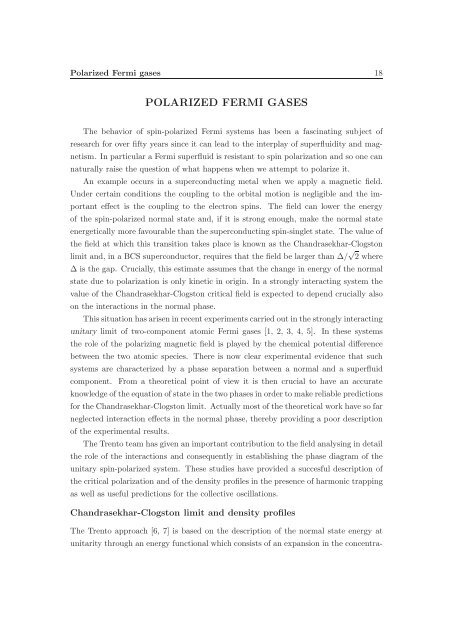Scientific Report - BEC
Scientific Report - BEC
Scientific Report - BEC
You also want an ePaper? Increase the reach of your titles
YUMPU automatically turns print PDFs into web optimized ePapers that Google loves.
Polarized Fermi gases 18POLARIZED FERMI GASESThe behavior of spin-polarized Fermi systems has been a fascinating subject ofresearch for over fifty years since it can lead to the interplay of superfluidity and magnetism.In particular a Fermi superfluid is resistant to spin polarization and so one cannaturally raise the question of what happens when we attempt to polarize it.An example occurs in a superconducting metal when we apply a magnetic field.Under certain conditions the coupling to the orbital motion is negligible and the importanteffect is the coupling to the electron spins. The field can lower the energyof the spin-polarized normal state and, if it is strong enough, make the normal stateenergetically more favourable than the superconducting spin-singlet state. The value ofthe field at which this transition takes place is known as the Chandrasekhar-Clogstonlimit and, in a BCS superconductor, requires that the field be larger than Δ/ √ 2whereΔ is the gap. Crucially, this estimate assumes that the change in energy of the normalstate due to polarization is only kinetic in origin. In a strongly interacting system thevalue of the Chandrasekhar-Clogston critical field is expected to depend crucially alsoon the interactions in the normal phase.This situation has arisen in recent experiments carried out in the strongly interactingunitary limit of two-component atomic Fermi gases [1, 2, 3, 4, 5]. In these systemsthe role of the polarizing magnetic field is played by the chemical potential differencebetween the two atomic species. There is now clear experimental evidence that suchsystems are characterized by a phase separation between a normal and a superfluidcomponent. From a theoretical point of view it is then crucial to have an accurateknowledge of the equation of state in the two phases in order to make reliable predictionsfor the Chandrasekhar-Clogston limit. Actually most of the theoretical work have so farneglected interaction effects in the normal phase, thereby providing a poor descriptionof the experimental results.The Trento team has given an important contribution to the field analysing in detailthe role of the interactions and consequently in establishing the phase diagram of theunitary spin-polarized system. These studies have provided a succesful description ofthe critical polarization and of the density profiles in the presence of harmonic trappingas well as useful predictions for the collective oscillations.Chandrasekhar-Clogston limit and density profilesThe Trento approach [6, 7] is based on the description of the normal state energy atunitarity through an energy functional which consists of an expansion in the concentra-




